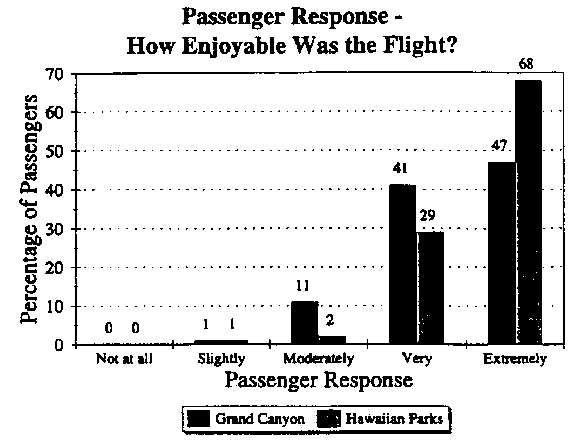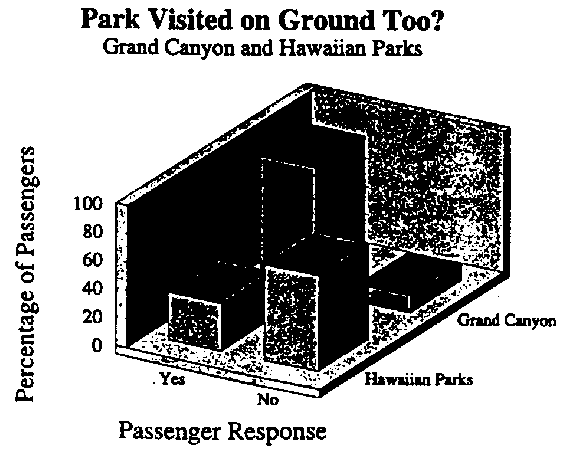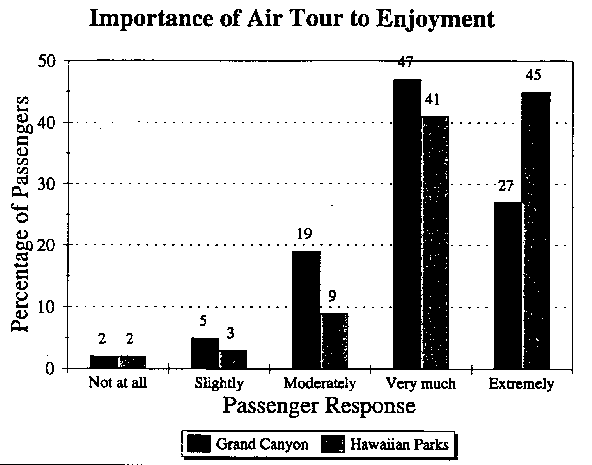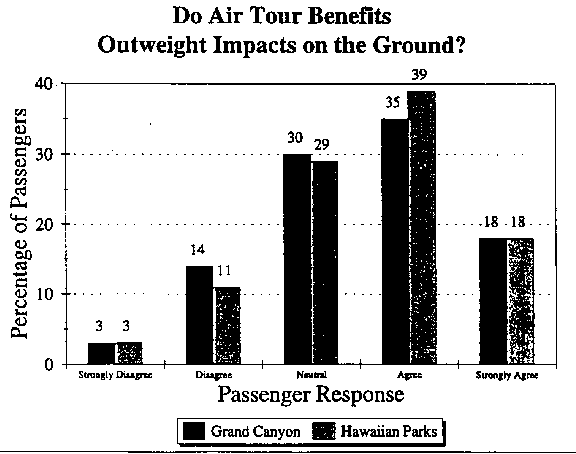
Section 1 of Public Law l00-91 mandates that the National Park Service assess the values associated with aircraft overflights of parks:
"The research at each such [park] unit shall provide information and an evaluation regarding each of the following...
"(4) the values associated with aircraft flights over such units of the National Park System in terms of visitor enjoyment, the protection of persons or property, search and rescue operations and fire fighting.””
The NPS interpreted this to mean that it should assess the values associated with administrative and air-tour overflights, and that military, commercial, and general aviation flight activity should not be included within the scope of investigation. Consequently, this chapter reports on four topics: the values accruing to parks and park visitors from the NPS administrative overflights, the values associated with air tour flights of parks, the value of the air tour industry to local economies, and the values associated with aerial movie filming.
8.1 Values Associated with Administrative Use of Aircraft
Many units of the National Park System use aircraft to assist with management activities. Whether chartered, leased, or owned by the NPS, these aircraft must overfly the park by the very nature of their duties. Across the National Park System, in a twelve month period between 1992 and 1993, the NPS logged 19,133 hours of aircraft use. The Park Manager Survey (HBRS, Inc., 1993) to the subset of 98 parks indicating some type of aircraft overflight problem provides more insight about the NPS use of aircraft. The responses from the 91 parks that returned completed questionnaires are examined in this section.
In the survey, managers were first asked whether their park ever used aircraft in an administrative capacity; sixty-five percent of the parks surveyed reported using aircraft, almost twice as many as did not. Querying further, the questionnaire asked those managers answering in the affirmative what type of aircraft were used (helicopter or fixed-wing). Virtually all the parks surveyed used helicopters, and approximately 3/4 of the parks surveyed use fixed-wing aircraft. The majority of parks use both types of aircraft. (For the National Park System as a whole, administrative uses of aircraft accounted for 11,595 hours in fixed-wing aircraft and 7,548 hours in helicopters. )
Previous Chapter
Top of Chapter 8
Table of Contents
Return to NPC Library
Return to NPC Home Page
Managers were then asked what sorts of management activities most often employed the use of aircraft. Seven activities were consistently named by managers. Figure 8.1 identifies these activities. The figure also shows the percentage of parks that use aircraft in support of each activity. For each of the seven activities, over 50 percent of the parks used aircraft in support of the activity during the prior year. The two most frequently mentioned activities were search and rescue, and resource management. [Compared to systemwide flying, parks in this sampled subset of parks did more flying for fire fighting and law enforcement and less for administrative, maintenance, and search and rescue purposes.]
To ascertain the extent to which aircraft are used for these management activities by individual parks, managers were asked to provide the number of flying hours their park logged in support of each activity. Figures 8.2 and 8.3 summarize the manager's responses. Figure 8.2 shows annual helicopter flight hours, and Figure 8.3 shows annual fixed-wing flight hours. Each of the averages for each management activity were obtained by including the hours of just those parks reporting the use of aircraft in support of that activity. Hence, for those parks that use helicopters to assist in law enforcement, the average reported number of annual flying hours was 27. For parks using fixed-wing aircraft for law enforcement, the average number of flying hours was 39. It should be noted that in general managers reported the overflights by aircraft on park business (for management purposes or emergencies) make up a small fraction of all overflights (see Chapter 2, Section 2.1.1).
Fire fighting clearly involved the greatest number of flying hours, with helicopters rather than fixed-wing showing the bulk of the hours. The remainder of the management activities involve substantially less use of aircraft.
Conclusion 8.1:
NPS managers believe that aviation is essential to the management of many national parks. Parks and visitors benefit from the administrative use of aircraft for search and rescue, science and resource management, firefighting, law enforcement, maintenance, etc.
8.2 Values Associated with Aerial Tourism
Historically, air tour passengers have not been formally considered as "park visitors. " Nonetheless, a large number of people do see Grand Canyon, Haleakala, Hawaii Volcanoes, and other national parks from the air. This section explores the results of a survey of air tour passengers from the Grand Canyon, Haleakala, and Hawaii Volcanoes National Parks (McDonald et al. 1994). Figure 8.4 shows estimates of annual visitation by land and by air for these parks. Bars show the ground visitation (number of people entering the park through roadway entrance stations). The other bars show air visitation (the number of air tour passenger-trips, to the extent that it can be estimated). The figure suggest that a sizable minority of visitors take advantage of the opportunity to view these parks, especially the Grand Canyon, by air.
Top of Chapter 8
Table of Contents
Return to NPC Library
Return to NPC Home Page




Top of Chapter 8
Table of Contents
Return to NPC Library
Return to NPC Home Page
8.2.1 Tour Passenger Survey Results
The Air Tour Passenger Survey results must be interpreted with great caution because of sampling problems that occurred during the study. During the fall of 1992 a survey of air tour passengers was conducted for these three parks. A questionnaire was mailed to randomly selected passengers after they completed their flights. But the extent to which inference can be made to air tour passengers over these parks is suspect due to a lack of cooperation by major segments of the air tour industry. The manner in which cooperating air tour companies collected names (asking for volunteers from their clients rather than providing the MS a complete list of clients from which to sample) introduced the possibility of bias in the sample. As a result, the MS abandoned an attempt to survey air tour passenger elsewhere in the country during the summer of 1993. The following results from the survey should be read and understood in that context.
ENJOYMENT AND APPRECIATION OF THE PARK. The results of the survey showed that overall enjoyment was rated high by most passengers. Figure 8.5 shows that over 95 percent of the passengers felt their flights were "moderately,” "very," or "extremely" enjoyable. Almost 50 percent of the passengers rated enjoyment in the "extreme" category alone.
When asked how much their appreciation of the park had increased as a result of their flight, passengers showed similar feelings of enthusiasm. Figure 8.6 shows that over 95 percent of the passengers reported their appreciation had been increased by a moderate to an extreme degree. When asked if they would recommend the flight to others, the trend continued, with over 95 percent of the passengers providing positive responses (Figure 8.7). Perhaps a part of this enthusiasm can be explained by the fact that this was the first air tour for most of the passengers surveyed. Figure 8.8 shows that over 95 percent of the passengers were experiencing their first air tour of a national park.
REASONS FOR TAKING AIR TOURS. The survey asked passengers the main reason they took an air tour. Figure 8.9 shows that more than one-half of the passengers reported the unique perspective afforded by the tour to be the primary reason. The second most frequently mentioned main reason was that the air tour afforded a fast means for seeing large expanses of the park. The third most frequently cited reason was the novelty of the air tour. Fourth, health or physical disabilities were identified, as well as a variety of other reasons. The survey also asked passengers about other factors that influenced their decision to take an air tour. Figures 8.10, 8.11 and 8.12 show the reported importance of time constraints, a desire for a unique perspective, and health limitations. The unique perspective was the most important reason given for making the flight.
VISITING THE PARK ON THE GROUND. The findings presented thus far show reasonable consistency between the Hawaiian parks and Grand Canyon. One finding of the survey which was not consistent across the parks was the proportion of tour passengers who had (or were about to) tour the park on the ground. The results differed significantly. Figure 8.13 shows that the proportion of Grand Canyon passengers also touring on the ground to be about 90 percent. In the Hawaii parks, however, this proportion drops to about 30 percent.
Top of Chapter 8
Table of Contents
Return to NPC Library
Return to NPC Home Page




Top of Chapter 8
Table of Contents
Return to NPC Library
Return to NPC Home Page


Top of Chapter 8
Table of Contents
Return to NPC Library
Return to NPC Home Page



Top of Chapter 8
Table of Contents
Return to NPC Library
Return to NPC Home Page
Air tour passengers who were also touring the park on the ground during their visit were asked to rate separately the importance of the air tour and the importance of the ground tour to their overall enjoyment of the park. Figures 8.14 and 8.15, respectively, show the passengers' responses. Over 90 percent of passengers reported moderate to extreme importance for both visitation modes, with little preference for one mode over the other. Neither was there a dramatic difference in preference between the Grand Canyon and the Hawaiian parks, though the Grand Canyon passengers show a slight weighting toward the importance of the ground tour versus the air tour, while the Hawaiian passengers report somewhat more importance for the air tour.
Judgments of Impacts to Visitors on the Ground. Finally, passengers were asked about their impressions of how disruptive air tour flights were to visitors on the ground. Figure 8.16 shows that approximately 75 percent of air tour passengers feel these flights are minimally disruptive ("Not at all " or "Slightly"). Only 10 percent expressed the opinion that air tour flights were moderately to extremely disruptive.
Figure 8.17 shows passengers' opinions about the tradeoff between the benefits of air tours and the disruptive effects they may cause on the ground. Passengers were asked to respond to the statement that "Benefits to tour passengers outweigh disturbances on the ground. " Approximately 30 percent gave a neutral response. On either side of neutral, about 55 percent agreed or strongly agreed with the statement, and only about 15 percent disagreed or strongly disagreed.
Conclusion 8.2
Air tour passengers surveyed indicated immense enjoyment from their tour experiences, would recommend the tour to others, and believed it increased their appreciation of the park.
Conclusion 8.3
Unique perspective and time constraints were the most important reasons for taking flights over parks. Health reasons were less important though not an insignificant consideration.
Conclusion 8.4
Air tour passengers over the Grand Canyon typically also visit that park using ground transportation, while those in Hawaii do not.
Conclusion 8.5
Air tour passengers do not think tours cause an impact to visitors on the ground.
8.2.2 Are Air Tour Passengers Park Visitors?
To the extent that these results are accurate, they confirm what tour operators assert: most air tour passengers enjoy immensely their tour experiences, would recommend such tours to others, and believe the tours significantly increased their appreciation of the park. In a sense, these passengers enjoy some of the same qualities the park has to offer on-ground park visitors. Some air tour operators assert that their passengers are indeed park visitors and these operators are proud of their contribution to visitor enjoyment of parks.
But for the NPS, there is a difference. For all ground visitors, the NPS is able to regulate numbers and types of visitor activities in the parks in order to preserve resources and ensure quality visitor experiences. Numbers of raft trips in the Grand Canyon and other parks are limited, with waiting lists of many years.
Top of Chapter 8
Table of Contents
Return to NPC Library
Return to NPC Home Page


Top of Chapter 8
Table of Contents
Return to NPC Library
Return to NPC Home Page


Top of Chapter 8
Table of Contents
Return to NPC Library
Return to NPC Home Page
The number of backcountry use permits issued each year is limited. The number of camp sites is limited as are numbers of hotel or lodge rooms or cabins. The purpose of these NPS activities is to limit the adverse impacts one visitor activity has on others and on the park itself. The purpose of parks is to preserve resources and ensure that succeeding generations have a chance to experience the same types of opportunities. Anything less is an abrogation of NPS responsibility to preserve and protect the parks.
Air tour operators have consistently objected to NPS efforts to work with the FAA in protecting park values and resources. They argue that the NPS has no right or responsibility to be involved in influencing airspace management. They also proclaim that air tours cause the fewest environmental impacts of all methods by which the parks may be seen or appreciated, ignoring the fact that most air tour passengers impact the park twice - first from the air and later when they visit on the ground.
The NPS perspective is that there are impacts to visitors from aircraft overflights, as discussed in Chapter 6. These impacts vary depending upon location, visitor activity, aircraft-produced sound exposure, ambient sound levels, and other factors, but roughly 30 to 40 percent of Grand Canyon backcountry visitors reported moderate to extreme annoyance with the sound of aircraft, and 40 to 50 percent reported that the sound of aircraft interfered with their appreciation of natural quiet, see Figure 6.1. Additionally, Chapter 3 showed that, primarily because of the low non-aircraft ambient sound levels in parks, even distant aircraft can be easily heard. Hence, overflights do produce impacts, both directly on visitors as well as on the natural quiet resource provided by parks to ground-based visitors.
Perhaps this dichotomy between people who enjoy air tours over national parks and people who find that overflights impair their enjoyment of the parks is ironically summarized by the responses to one of the questions in the Visitors Survey discussed in Chapter 6. Upon being asked how hearing or seeing aircraft affected their visit to the park, about 20 percent said they felt like complaining to somebody, and about 20 percent said it made them want to view the park from the air (McDonald et al. 1994).
Air tours do offer access to parks and provide for enjoyment of those parks. But the access produces impacts on other visitors and on the park. While the NPS has traditionally managed visitor use to conserve the parks and provide for their enjoyment by current and future generations of visitors, the FAA has sole control over all airspace and over the activities of aircraft owners and operators. The NPS and the FAA face two basic choices for dealing with this situation:
COOPERATION: The two agencies can cooperate in reducing the impacts of air tours on parks and maintaining the benefits provided by air tours in a way that maximizes the safe and efficient use of the airspace. An example of this would be an FAA permit process for air tour operations utilizing and marketing NPS resources in which the NPS superintendent would be required to sign off that the operation was beneficial to park visitors and park transportation needs, and/or not an impact to the park or park visitors in the locations proposed.
LEGISLATION: The alternative is that "cooperation" can be legislatively accomplished when the problem reaches unmanageable proportions. Evidence that some do not have confidence in the ability of the two agencies to cooperate is evidenced by three proposals for legislation (See Appendix C):
H.R. 1696: Hawaii Overflight Protection Act, a bill that would protect the parks in Hawaii by requiring specified stand-off distances and minimum altitude zones over those parks;
Top of Chapter 8
Table of Contents
Return to NPC Library
Return to NPC Home Page
H.R. 4163: National Park Scenic Overflight Concessions Act of 1994, a bill to enable the Park Service to regulate, or prohibit, scenic commercial overflights at units of the National Park System as it does other services provided in parks;
S. 2428: National Parks Airspace Management Act of 1994, a bill that would provide for the regulation of the airspace over National Park Service lands in the United States by the FAA in consultation with the NPS.
As a part of this study, a legal review of FAA and NPS authorities was conducted (See Appendix D). Between the two agencies, legal authorities appear to be adequate to address the impacts identified in this report. So the real question is whether and how these authorities are applied to the identified impacts.
8.3 Value of Overflights to Local Economies
Limited information is available on the economics of air tourism in the United States, especially over national parks. It is privileged economic data that the FAA does not collect. Based on industry reports, the economic impact of Grand Canyon air tours alone is two hundred and fifty million dollars ($250,000,000). The industry in Hawaii is apparently very nearly as large, and there is a sizable industry in other parts of the country including New York, St. Louis, and Southeastern Alaska. The FAA estimates that there are at least 187 air tours operators across the nation. This suggests the total economic impact of the industry is in the range of one-half to three-quarters of a billion dollars a year.
8.4 Values and Impacts of Aerial Filming
A substantial amount of aerial filming is completed in units of the National Park System, although again, there is no readily accessible information on its extent. The NPS tends to be responsive to filming requests of all types that are non-degrading to the parks or the visitor experience. Yet it is worth noting that overflight impacts can occur as a result of these activities as well. An example is illustrative.
In October, 1993, a regional film company was issued a commercial film permit to make an IMAX-style film that focused heavily on one of the national parks in Utah. In order to protect park values of silence and solitude and to protect threatened and endangered species, the permit from the park contained a stipulation that no filming by fixed wing or helicopter would be allowed. A $25,000 performance bond was posted and then returned when the filming was completed. In early March, 1994, park rangers noted unauthorized filming by this same company over the park and surrounding areas using helicopters. The park had no legal recourse since neither NPS nor FAA regulations were broken. Nonetheless, the park considers the disregard of permit conditions in the filming permit to be an example of an abuse that should not be permitted to continue. [The FAA is initiating a change to internal policy regarding issuance of waivers dealing with movie production as a result of the Zion incident].
Top of Chapter 8
Table of Contents
Return to NPC Library
Return to NPC Home Page
National parks and park visitors benefit from the use of aviation: visitors are aided through search and rescue flights ; parks and the nation benefit from fire fighting's use of aircraft; and aviation aids research, resource management, and law enforcement in parks. Air tour passengers also benefit from aviation. Passengers find their experiences to be very rewarding, both in terms of overall enjoyment as well as in providing an enhanced appreciation for the park. Aviation is also a major economic factor in some places, most notably around the Grand Canyon and in Hawaii. However, the potential exists for expanded operations in many parks.
Perhaps the most important conclusion, though it must be inferred, is the likelihood that there will be increasing airspace issues over the National Park System. The high degree of satisfaction with air tours expressed by passengers, the willingness of tourists to spend the money for air tours, and regulations that provide FAA with sole authority to control airspace use, all suggest that air tour operations will increase, while the NPS will continue to live with the consequences -- until a cooperative process is developed for limiting the impacts produced by these overflights. The NPS concludes that a process, binding upon all parties, must be designed and implemented to identify, measure and limit overflight produced problems in units of the National Park System. Voluntary agreements may be part of this process, but they cannot stand alone because of their limited effectiveness.
Next Chapter
Top of Chapter 8
Table of Contents
![]()